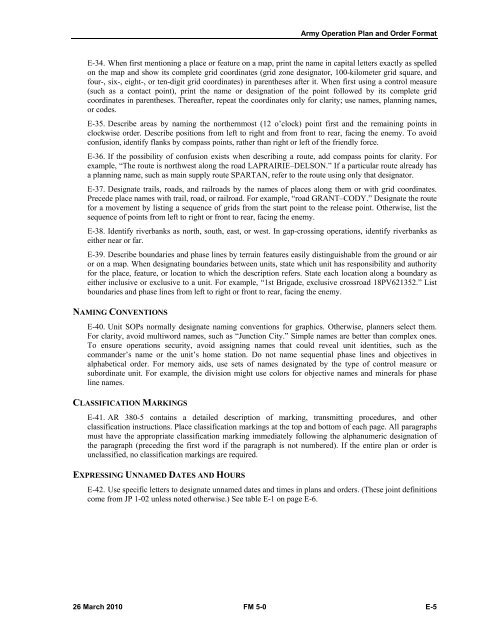FM 5-0, The Operations Process - Federation of American Scientists
FM 5-0, The Operations Process - Federation of American Scientists
FM 5-0, The Operations Process - Federation of American Scientists
You also want an ePaper? Increase the reach of your titles
YUMPU automatically turns print PDFs into web optimized ePapers that Google loves.
Army Operation Plan and Order Format<br />
E-34. When first mentioning a place or feature on a map, print the name in capital letters exactly as spelled<br />
on the map and show its complete grid coordinates (grid zone designator, 100-kilometer grid square, and<br />
four-, six-, eight-, or ten-digit grid coordinates) in parentheses after it. When first using a control measure<br />
(such as a contact point), print the name or designation <strong>of</strong> the point followed by its complete grid<br />
coordinates in parentheses. <strong>The</strong>reafter, repeat the coordinates only for clarity; use names, planning names,<br />
or codes.<br />
E-35. Describe areas by naming the northernmost (12 o’clock) point first and the remaining points in<br />
clockwise order. Describe positions from left to right and from front to rear, facing the enemy. To avoid<br />
confusion, identify flanks by compass points, rather than right or left <strong>of</strong> the friendly force.<br />
E-36. If the possibility <strong>of</strong> confusion exists when describing a route, add compass points for clarity. For<br />
example, “<strong>The</strong> route is northwest along the road LAPRAIRIE–DELSON.” If a particular route already has<br />
a planning name, such as main supply route SPARTAN, refer to the route using only that designator.<br />
E-37. Designate trails, roads, and railroads by the names <strong>of</strong> places along them or with grid coordinates.<br />
Precede place names with trail, road, or railroad. For example, “road GRANT–CODY.” Designate the route<br />
for a movement by listing a sequence <strong>of</strong> grids from the start point to the release point. Otherwise, list the<br />
sequence <strong>of</strong> points from left to right or front to rear, facing the enemy.<br />
E-38. Identify riverbanks as north, south, east, or west. In gap-crossing operations, identify riverbanks as<br />
either near or far.<br />
E-39. Describe boundaries and phase lines by terrain features easily distinguishable from the ground or air<br />
or on a map. When designating boundaries between units, state which unit has responsibility and authority<br />
for the place, feature, or location to which the description refers. State each location along a boundary as<br />
either inclusive or exclusive to a unit. For example, “1st Brigade, exclusive crossroad 18PV621352.” List<br />
boundaries and phase lines from left to right or front to rear, facing the enemy.<br />
NAMING CONVENTIONS<br />
E-40. Unit SOPs normally designate naming conventions for graphics. Otherwise, planners select them.<br />
For clarity, avoid multiword names, such as “Junction City.” Simple names are better than complex ones.<br />
To ensure operations security, avoid assigning names that could reveal unit identities, such as the<br />
commander’s name or the unit’s home station. Do not name sequential phase lines and objectives in<br />
alphabetical order. For memory aids, use sets <strong>of</strong> names designated by the type <strong>of</strong> control measure or<br />
subordinate unit. For example, the division might use colors for objective names and minerals for phase<br />
line names.<br />
CLASSIFICATION MARKINGS<br />
E-41. AR 380-5 contains a detailed description <strong>of</strong> marking, transmitting procedures, and other<br />
classification instructions. Place classification markings at the top and bottom <strong>of</strong> each page. All paragraphs<br />
must have the appropriate classification marking immediately following the alphanumeric designation <strong>of</strong><br />
the paragraph (preceding the first word if the paragraph is not numbered). If the entire plan or order is<br />
unclassified, no classification markings are required.<br />
EXPRESSING UNNAMED DATES AND HOURS<br />
E-42. Use specific letters to designate unnamed dates and times in plans and orders. (<strong>The</strong>se joint definitions<br />
come from JP 1-02 unless noted otherwise.) See table E-1 on page E-6.<br />
26 March 2010 <strong>FM</strong> 5-0 E-5















